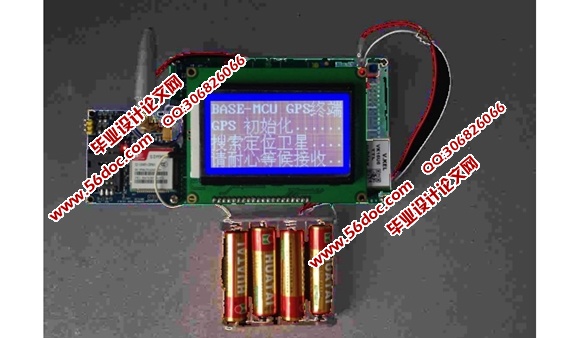多功能方位指示,定位器的研究(含电路原理图,程序)

多功能方位指示,定位器的研究(含电路原理图,程序)(课题申报表,任务书,开题报告,中期检查表,外文翻译,论文21000字,程序,答辩PPT)
摘 要
GPS是全球定位系统英文名词Global Positioning System的缩写。该系统是美国第二代卫星无线电导航系统。它能为用户提供全球性、全天候、连续、实时、高精度的三维坐标、三向速度和时间信息。其目的是在全球范围内对地面和空中目标进行准确定位和监测。现在GPS接收机作为一种先进的导航和定位仪器,已在军事及民用领域得到广泛的应用。
论文主要研究GPS的定位原理与技术,专用的磁场传感器结合高速微控制器(MCU)的电子指南针及其实现方法,以软、硬件相结合的方式完成整个GPS数据接收和显示的过程。完成了一台液晶显示的手持式GPS定位接收设备,并依次显示实时时间及所在地的经纬度。通过采用磁阻(GMR)传感器采集某一方向磁场强度后,传送至MCU控制器对其数据进行处理并判断分析的结果,最后通过LCD显示屏显示出来。该定位系统完成后,定位精度能达到15m,所以该装置在测控领域的应用开发中具有一定的实用价值和借鉴价值。
关键词:GPS定位系统;电子指南针;液晶显示屏
Abstract
GPS is the abbreviation of the English term Global Positioning System global positioning system. The system is the United States laid the second generation satellite radio navigation system. It can provide users with continuous, real-time, global, round-the-clock, high precision three dimensional coordinates, three velocity and time information. Aimed at targets on the ground and in the air around the world an accurate positioning and monitoring. Now, as an advanced GPS receiver navigation and positioning equipment, has a wide range of applications in military and civilian areas. [来源:http://Doc163.com]
Thesis mainly research of GPS positioning principle and technology, special magnetic field sensor combination of high-speed microcontroller(MCU) electronic compass and its implementation method.Make a set of design proposal, with soft to link hardware accomplish whole GPS information acceptance and evincive process. Accomplish one handheld GPS position receiving machine with Liquid crystal display, and display real time period and the location of latitude and longitude one by one. By using magnetic resistance(GMR) sensors to collect a certain direction magnetic field intensity, sent to the MCU controller to deal with the data and to assess the results of the corresponding Angle, at last, through the LCD screen display.With the position system complete, the position precision can reach fifteen meters, so the system in measurement an control field application development have some practical worth and reference worth.
Key words:GPS positioning system; Electronic compass;LCD display
[来源:http://Doc163.com]
主要内容:
本文以GPS方位测量技术为研究对象,首先对GPS定位的方式进行研究。通过对现代定位技术的讨论,利用现有GPS测量模块的各种优势,并将这种方式应用于本设计系统。采用12864显示屏和单片机互连的终端系统,通过对GPS模块信号的解码,计算出所需的经纬度、海拔高度、运行时间等信息,再由单片机处理出所需的位置,速度,航向,相对高度等数。
基本要求:
1. 采用单片机设计简易方位测量装置,GPS模块测量定位,速度、方向、海拔高度以及利用电子指南针确定其方位;
2. 采用NEO-6M测量GPS卫星定位数据;
3. 采用12864液晶屏幕示测量数据;
整体设计
系统硬件部分电路大致上可以分成稳压电源、单片机小系统及外围电路和LCD显示屏电路三部分。
电路为单片机89C52控制的GPS器件,实现定位系统数据的采集和现实。其中所使用的器件主要是3个,打片机89C52、GPS模块GARMIN GPS25以及LCD显示模块MGLS-12032A。在这里仅列出单片机和LCD接口部分电路的器件名称和相关的主要功能。
89C52:LCD的控制器,控制字符的发送和点阵显示的时序。
MAX202:TTL电平和RS-232电平的转换芯片。 [资料来源:https://www.doc163.com]
LCD:液晶显示模块。在单片机的 控制下,按照要求的格式显示接受到的 数据。
[来源:http://www.doc163.com]





[资料来源:http://Doc163.com]
目 录
第1章 GPS系统概述...................................................1
1.1 GPS的发展与前景.........................................1
1.1.1初期GPS的形成.......................................1
1.1.2中国北斗卫星导航系统.................................2
1.2 GPS的系统...............................................3
1.2.1 GPS系统的组成.......................................3
1.2.2 GPS定位仪的应用.....................................5
1.3 GPS定位系统的运作方式...................................6
1.3.1 GPS定位系统的基本原理...............................6
1.3.2 GPS模块定位流程.....................................7
[资料来源:https://www.doc163.com]
1.3.3 GPS信号接收方案选择.................................8
1.3.4 GPS接收模块的研究......................................8
1.4 STC89C52单片机..........................................9
1.4.1 STC89C52介绍.......................................9
1.4.2 STC89C52主要功能....................................10
1.4.3 STC89C52功能特性描述................................10
1.5 电子指南针..............................................13
1.6 SIM900A.................................................15
第2章 系统硬件设计.................................................18
2.1 整体设计.................................................18 [版权所有:http://DOC163.com]
2.2 各个模块设计............................................20
2.2.1 单片机最小系统设计...................................20
2.2.2 电源模块设计........................................21
2.2.3 显示模块设计........................................22
2.2.4 GPS数据模块和其他模块设计...........................23
第3章 系统软件设计.................................................26
3.1 主程序.................................................26
3.1.1初始化模块.........................................26
3.1.2数据接收处理模块...................................26
3.2 显示部分...............................................27 [资料来源:Doc163.com]
3.3 系统主程序.............................................27
第4章 系统调试与性能测试........................................30
4.1 硬件测试...............................................30
4.2 软件测试...............................................30
4.3 结果分析...............................................32
结论...............................................................36
参考文献...........................................................37
致谢...............................................................39
附录...............................................................40
